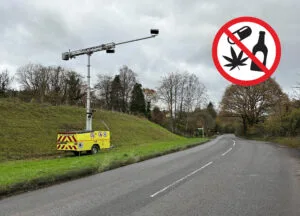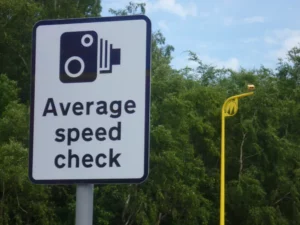ITS (UK) Executive Member Transport for London has launched five new mobile safety cameras to tackle the risk and harm caused by speeding across London and help meet its Vision Zero goal of eliminating death and serious injury on the road network. Police data shows that half of fatal collisions in London have speed as a factor.
The new laser cameras are being operated by a team of Police Community and Support Officers (PCSOs) in the MPS Roads and Transport Policing Command (RTPC) for the first time. The ability to relocate the cameras to where they are most needed means that they can be used to target non-compliance ‘hot-spots’ and in areas where local communities are concerned about speeding on residential roads. This capability ensures that TfL and the police can be more responsive to local community concerns and emerging problems. Since the new cameras have been in operation the MPS have enforced 9,500 speeding offences with them, including one driver who was travelling at 90mph in a 30mph speed limit.
The laser cameras complement other policing and enforcement activity to tackle speeding which includes London’s extensive fixed safety camera network, police roadside enforcement using speed guns and Community Roadwatch where community volunteers work with police to catch speeding motorists.
TfL has been working with the Met to increase the level of police enforcement and tackle speeding and the harm it causes, with the aim of having the capacity to enforce up to one million speeding offences by 2024/25. In 2021/2022, the Met enforced 476,685 speeding offences, 199,105 more than in the previous year and an increase of 72 per cent. Collision data from around the world shows that the speed at which people are driving or riding is the single most important factor in whether a crash takes place and how severely people are injured. The devastating impact speeding can have on local communities is why speed enforcement across London is so important for TfL and the police.
Reducing danger on the capital’s transport network is a top priority for TfL. In March 2020, TfL introduced a 20mph speed limit on all of its roads within the central London Congestion Charging zone as part of its Vision Zero commitment to eliminate death and serious injury on the capital’s roads by 2041, and 80km of its roads are now 20mph. TfL is now working to lower speeds on 220km of its roads by 2024 in inner and outer London, and recently launched 13.77km of new lower speed limit schemes in February 2022.
The Deputy Mayor for Transport, Seb Dance, said: “Reducing danger on the capital’s road transport network is a top priority, and lowering speeds is one of the most important things that we can do to make London’s streets safer.
“London has made huge strides in reducing road danger since adopting the Vision Zero goal for London and committing to eliminate all deaths and serious injuries from London’s streets by 2041, but there is still a long way to go. That’s why I welcome this work by TfL and the MPS to increase enforcement activity in order to tackle speeding. These new measures will enable police to focus on the areas where there are persistent problems and work to address local community concerns. This is a vital step in creating a safer and healthier London.”
Siwan Hayward, TfL’s Director of Compliance, Policing, Operations and Security, said: “Breaking the speed limit is dangerous and selfish. Drivers and riders travelling too fast are more likely to have a collision, with speed being a factor in almost half of fatal collisions in London. Working with the MPS and City of London Police, we are taking robust action against drivers who continue to speed, putting themselves and others at risk on London’s roads. This new equipment helps to increase levels and coverage of enforcement activity against speeding drivers across London. We urge drivers to slow down.”
Chief Superintendent Simon Ovens of the Met’s Roads and Transport Policing Command said: “The Met’s Roads and Transport Policing Command, in partnership with Transport for London, is working hard to reduce collisions and the number of people killed or seriously injured on London’s roads.
“We know that excess speed is directly linked to deaths and serious injuries on London roads. The increase in speed cameras extends our ability to take action and makes a statement that speeding will not be tolerated.”
Amy Aeron-Thomas, Action Vision Zero’s Roads Policing Campaign Coordinator, said: “Speeding in London remains a huge problem and it is great to see TfL and the Metropolitan Police expanding their enforcement across a wide range of locations with these new mobile cameras. Even if a driver speeding does not cause injury or even worse death, it is still intimidating and puts people off cycling and walking. Action Vision Zero believes that tackling speeding is key to reducing the risk of injury as well as car use, air pollution, carbon emissions and oil consumption. We need speed enforcement now more than ever.”
RoadPeace CEO Nick Simmons said: “RoadPeace strongly support this important initiative. Mobile speed enforcement cameras will be a key enforcement tool as well as, hopefully, a visible deterrent to those drivers who don’t follow the law. Our members know that speeding is a leading cause of road crashes and has a traumatic impact on many lives so we are pleased to see TfL and the MPS take another significant step towards Vision Zero”
TfL continues to work on a number of major programmes to make London’s roads and the vehicles using them safer. TfL’s world-first Direct Vision Standard, which reduces lethal blind spots on lorries, is already helping to save lives and prevent life-changing injuries. The scheme requires owners of Heavy Good Vehicles (HGVs) weighing more than 12 tonnes to apply for a free permit that assigns vehicles a star rating based on how much the driver can see directly through their cab windows in order to be able to drive in London. Since its introduction, more than 112,259 HGVs have had safe systems fitted, improving protection for people walking, cycling or riding e-scooters or motorcycles and saving lives.
In addition to the record-breaking growth seen in London’s cycle network over the past five years, with 260km of safer, high-quality cycle routes delivered by TfL and the boroughs, TfL has continued to work on its Safer Junctions programme to make life-saving changes at some of the capital’s most dangerous and intimidating junctions. To date, TfL has completed work at a total of 43 junctions, with more in the pipeline.
TfL, in partnership with London Councils and the MPS last year published a progress report that outlines achievements from the past three years and commits to new tougher measures to ensure it meets its Vision Zero goal of eliminating death and serious injury from London’s roads by 2041.
(Picture – TfL)

























